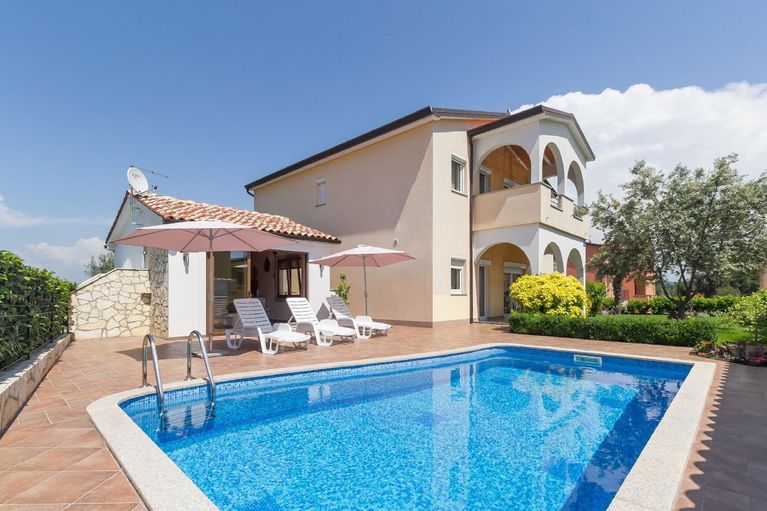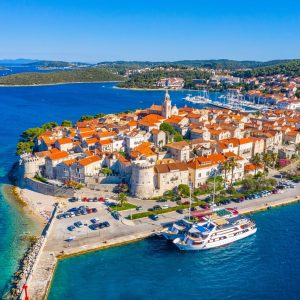

The island of Korčula, located in the southern Adriatic, is a jewel of Croatia and is known for its rich history and breathtaking landscapes. The old town of Korčula, often referred to as “Little Dubrovnik”, impresses visitors with its well-preserved medieval architecture and unique flair.
In the narrow streets, surrounded by historic buildings, you quickly feel transported to another time. The cultural and historical significance of the old town makes it an unmissable destination for anyone who wants to discover the beauties of the Croatian coast.
But before we look at the sights of Korčula Old Town, it is important to first mention the history of the city.
The history of the town of Korčula dates back to ancient times. Greek settlers called the island Korkyra Melaina , which means “Black Corfu”. This name referred to the dense forests that once covered the island. Later, the island became part of the Roman Empire and then ruled by the Byzantines and Venetians.
The Venetians left a deep cultural and architectural influence that is still visible in the old town today. In the Middle Ages, Korčula was an important trading centre and the seat of numerous noble families, which contributed to the town’s prosperity and made it an important hub in the Adriatic Sea.
The town is built on a peninsula, which gave it a natural defensive position. This historical depth and the well-preserved buildings are among the most important sights in Korčula Old Town and offer an insight into the island’s eventful past.
The old town of Korčula impresses with its well-preserved medieval architecture and sophisticated urban planning. The city walls and defensive towers that surround the old town are testament to the city’s strategic importance in the Middle Ages.
St. Mark’s Cathedral, or Sveti Marko, is the central architectural highlight of Korčula’s Old Town and a significant example of Gothic-Romanesque architecture. Built in the 15th century, this impressive cathedral stands majestically above the town’s main square. The cathedral’s façade is decorated with numerous sculptures and reliefs depicting biblical scenes and saints.
The interior of St. Mark’s Cathedral is as impressive as its exterior. The chancel houses magnificent altars decorated with gold and marble, as well as valuable paintings and sculptures, including works by the famous Venetian artist Tintoretto.
Historically, the cathedral played a central role in the religious and social life of Korčula. The construction and maintenance of this cathedral reflects the prosperity and cultural importance of Korčula and makes it one of the most important Korčula Old Town attractions.
Marco Polo, the famous explorer and traveller, is often associated with the island of Korčula, as legends say that he was born here. This assumption is based on historical records and the presence of a house in the old town of Korčula, which is said to be his birthplace.
Marco Polo, born in 1254, is known for his travels to Asia and his detailed accounts of the lands and cultures there, which he recorded in “Il Milione”. These accounts inspired many explorers, including Christopher Columbus. The stories about his origins in Korčula may stem from the historic naval battle between the Republic of Venice and the Republic of Genoa in 1298, during which Marco Polo was captured and later imprisoned in Genoa, where he documented his travels.
The supposed birthplace of Marco Polo in Korčula is now a museum that offers visitors insight into the life and travels of the famous explorer. The house is located in the old town and is a popular destination for tourists interested in history and adventure.
The city walls and defensive towers of Korčula’s old town are impressive examples of medieval architecture and defensive art. These fortifications, built between the 13th and 15th centuries, served to protect the city from attacks and pirate raids.
Originally, the walls surrounded the entire peninsula on which the Old Town is located, providing an effective defense against enemies. A walk along the city walls offers a fascinating insight into the history and architecture of the city. The most famous towers include the Revelin Tower and the Veliki Revelin, which are prominent features of the city walls.
Walking along the walls offers a wonderful view of the deep blue Adriatic Sea and the neighboring islands. There are viewpoints at various points along the walls from which you can overlook the picturesque surroundings and the city itself.
Exploring Korčula Old Town sights begins at the impressive city gate, which together with the monumental staircase forms a majestic entrance. The city gate, known as the Land Gate (Veliki Revelin), was built in the 17th century and is an excellent example of the Venetian architecture that shapes the history and heritage of the city.
When you enter the old town through the city gate, you immediately feel as if you have been transported to another time. The gate itself is decorated with the city’s coat of arms and the Venetian lions, which are a reminder of Venice’s long rule over Korčula. Inside the gate, a world of narrow, cobbled streets, picturesque squares and historic buildings opens up.
The stairs and the city gate are not only functional elements, but also symbols of the rich history and culture of Korčula. They mark the beginning of a journey through time and invite you to discover the many stories and sights of Korčula Old Town.
Whether you visit the cathedral, the city walls or the Marco Polo House, the trail begins here, at this impressive entrance that reflects the splendor and charm of Korčula.
The Korčula Town Museum, located in the historic 16th-century Gabrielis Palace, offers visitors an in-depth look into the rich history and cultural heritage of the town and the island. Its most significant exhibits include archaeological finds dating back to prehistoric times, including tools, ceramics and other artifacts that shed light on the early life and settlement of the island.
A special focus is on the Greek and Roman periods, during which Korčula played an important role in the Adriatic trade network. The museum also houses an impressive collection of medieval art and crafts. These include religious sculptures, paintings and altars that document the spiritual and artistic development of the island during the Middle Ages.
A visit to the Korčula Town Museum is an enriching experience that brings the past to life and provides a comprehensive overview of the island’s cultural and historical developments. It is an essential stop for anyone exploring Korčula Old Town and its numerous attractions.
Korčula’s old town is a veritable labyrinth of narrow, cobbled streets and picturesque squares that take visitors on a journey back in time. A stroll through these alleys is like a journey through history. The narrow streets, often lined with high stone walls, open up into small squares surrounded by historic buildings, cozy cafes and traditional restaurants.
One of the most beautiful and famous squares is Trg Sv. Marka, the market square in front of St. Mark’s Cathedral. This square is not only an architectural highlight, but also a vibrant center of city life. Cultural events and markets often take place here, underlining the lively atmosphere of the city.
Another notable square is Trg Pomirenja, also known as the Square of Reconciliation. Surrounded by historic buildings and shady trees, this square is an ideal place to linger and observe the city’s hustle and bustle. The surrounding streets are full of boutiques, craft shops and galleries that invite you to browse and discover.
The alleys of the old town are often named after professions that were traditionally practiced there, such as Goldschmiedegasse or Fischergasse. This naming gives insight into the historical significance and daily life of the city’s inhabitants in the Middle Ages.
The best way to get to Korčula is by ferry from the Croatian mainland. There are frequent ferry connections from cities such as Split, Dubrovnik and Drvenik. The crossing offers breathtaking views of the Adriatic coast and the surrounding islands. It is best to explore Korčula Old Town sights on foot to fully enjoy the narrow streets and hidden squares. For longer distances on the island, bicycles can be rented, which is an environmentally friendly and active way of exploring.
Korčula enjoys a Mediterranean climate with hot, dry summers and mild, wet winters. The ideal time to visit is from May to October, when the weather is warm and sunny and the sea temperatures are ideal for swimming. July and August are the hottest months and also the peak season with the most visitors. Those looking for a more peaceful experience should consider spring or fall.
Korčula Old Town is a fascinating destination that captivates with its rich history, well-preserved architecture and charming atmosphere. From the majestic St. Mark’s Cathedral to the mysterious Marco Polo Birthplace to the impressive city walls and defense towers, the Old Town offers countless sights and experiences.